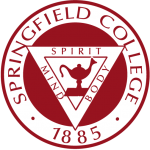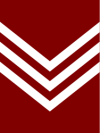Springfield College
Massachusetts
1885
Formerly “International Young Men’s Christian Association Training School” and “International YMCA College”




The International YMCA Training School was using maroon and white colors on diplomas in 1895, but it is not known when they were officially adopted as the colors of the school. Previously the colors were apparently scarlet (or bright red), gray, and white.
Citations in the World Almanac (listed by cover date; color information is from the previous year): maroon/white (1923-1935)
The International Young Men’s Christian Association (YMCA) Training School began conferring Bachelors and Masters degrees in Humanics and Bachelors and Masters degrees in Physical Education in 1905. When the YMCA Training School was accredited as International YMCA College in 1912, the Intercollegiate Bureau of Academic Costume (IBAC) approved Faculty colors for those degrees in Humanics (crimson) and Physical Education (sage green), and it was probably around this time that the IBAC assigned a hood lining pattern to the college.
A description of the International YMCA College’s hood lining pattern did not appear in an Intercollegiate Bureau list until 1927, where it was stated to be a single color of maroon. Unfortunately this was a duplication of the hood lining the University of Chicago adopted in 1896. When the International YMCA College became Springfield College in 1954, the IBAC may have reassigned the school a maroon hood lining with a white chevron, as this description appeared in a list compiled by Kevin Sheard in Academic Heraldry in America (1962) as well as Intercollegiate Bureau lists in 1969 and 1972. But this, too, was a duplication of another school’s hood lining: Lafayette College had been assigned a maroon hood lining with a white chevron in 1896. To avoid this problem, Springfield has been reassigned a new academic hood lining in maroon and white.
Another symbol of Springfield College is the inverted equilateral triangle. In 1889, a physical education faculty member at the International YMCA Training School named Luther H. Gulick proposed a unique symbol for the YMCA in the United States: a red inverted equilateral triangle with “Spirit”, “Mind”, and “Body” inscribed on the sides of the triangle. Gulick wrote that
the symbolic meaning of the Triangle as we use it is man in his three natures, physical, mental, and spiritual united so as to form one being. We believe that man is a unity formed of these three parts – the soul is not the man; the mind is not the man; the body is not the man. Man is the three in their proper relations to each other. Our Triangle is equilateral; by this we mean that each part should be equally developed, symmetrical with reference to itself, and also with reference to the other parts.
In 1891 the Board of Trustees of the International YMCA Training School adopted Gulick’s red triangle as the part of the official seal of the school, and five years later it became the symbol of the YMCA in the United States as well. In 1891 Gulick also created physical education uniforms for the International YMCA Training School that featured his triangle in scarlet, with a gray center upon which was embroidered the student’s graduation year in white. By 1895 the colors of the Training School had evolved to maroon and white.
Because this triangle cannot be attractively applied to the lining of an academic hood, here Springfield College has been reassigned a hood lined maroon with three white chevrons symbolizing the YMCA’s emphasis on the spirit, mind, and body.
